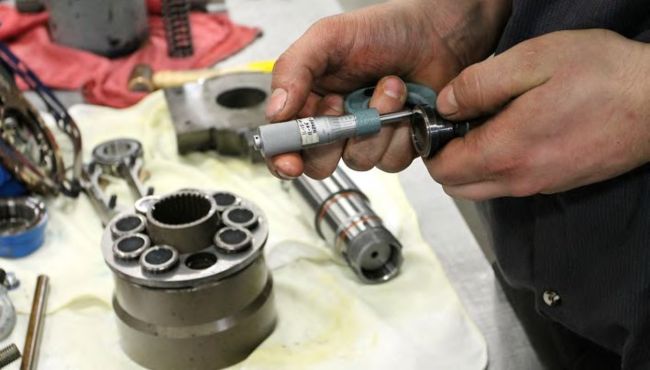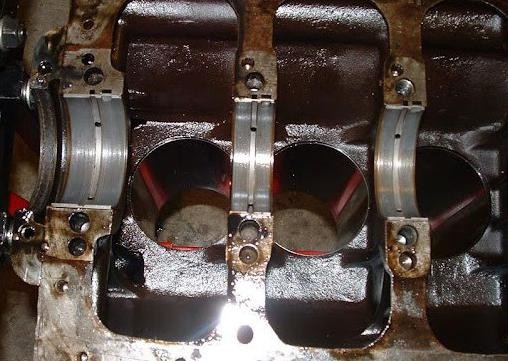PRODUCT APPLICATIONS
The state of tractor lubrication in Kenya
By Mr. Mohamed Baraka
It is the wish of the Government and the People of Kenya that the country increases food production to achieve security of supply at an affordable cost. It is for this reason that the county must increase mechanization of grain production. However, mechanization without proper lubrication and maintenance will be counterproductive. In this article we examine some of the mistakes made by farmers in lubrication of their tractors that result in high maintenance cost and shortened lifespan of the equipment.
The most critical parts of the tractor are engine, cooling systems, hydraulic & transmission systems and axles for 4-wheel tractors and bearings.
Nearly all tractors are equipped with high speed diesel engine oil. The lubricant that is required for such engines is American Petroleum Institute Classification (API) CI-4and above. .A good quality multigrade oil promotes easy start-up, fuel saving and long engine life. Lower quality oil will require more frequent oil top-up.
Many farmers use cheap oil without understanding that in lubrication, cheap is expensive. They thus use lubricants from recycled base oil with little or no use of additive. This is a serious mistake as the quality of the oil is low and it has a lot of contaminants including glycols from coolants and brake fluid. When subjected to high temperature, the oil quickly thickens; thus, starving the engine of lubrication. If not detected early, the engine could seize resulting in an expensive overhaul.
Oil with API CI-4will easily guarantee 300 engine hours while with oil made from recycled base oil, one will be lucky to get 100 engine hours. Considering that API CI-4is only twice the price of recycled product, in 300 engine hours one change of API CI-4is required, while using recycled base engine oil will require three oil changes. Already, one is spending more money on oil when using low quality oil than when using high quality oil One also spends three times on oil filters and labour charges. Additionally , frequent oil change increases the waste oil generated that always ends up contaminating both the soil and ground water . In particular contamination of the soil by waste oil leads to destruction of useful bacteria in the soil making the soil infertile hence reducing yields of crops.

Mr. Mohamed Baraka, is the Managing Director of Synergy Lubricant Solutions Limited, a Kenyan incorporated company manufacturing and marketing lubricants. He is the current chairman of Lubricant Task Force of Petroleum Institute of East Africa; the Lubricant Task Force is lobbying for quality lubricants and revival of local lubricant industry.
He can be reached at: mbaraka@slusollubes.com
Synergy Lubricants website; https://www.slusollubes.com/
>> Most of the time when I talk to tractor owners against using water in radiators, they get surprised and the common response is: “when Iwas born, my grandfather used water, my father used water so I use water.
The other common practice is to use engine oil SAE 40. Many people believe that since a tractor looks heavy, then it requires heavy oil. Others argue that their tractors are old with a lot of leakages and therefore with heavy oil, the rate of leakage will be lower. SAE 40 oils are of API CD or API CF which means the rate of oil change will be at most half the period one would get when one uses API CI-4. Again, lubrication cost using SAE 40 is higher than using API CI-4oil. SAE 40 also has a high environmental contamination. If the engine is leaking, it is excusable in a short term to use SAE 40 oil but repairs must be done quickly so as to revert to usage of high quality oil. When an engine leaks it also sucks dust from the atmosphere and this will accelerate engine wear. Frequent leaks also contaminate the environment.
The tractor hydraulic & transmission system is perhaps the most abused part of the tractor in Kenya. Most tractors have a combined hydraulic & transmission system. The lubricant used in the tractor hydraulic & transmission system must have Extreme Pressure (EP) properties required in a manual gearbox. The oil should be API GL-4. It should however be light enough to serve the hydrau-lic system and this is why gear oil SAE 90 or SAE 140 are not suitable for tractor transmissions. They are too heavy for the hydraulic pump and one will notice slow hydraulic response particularly in the morning when it is cold. Another function of tractor hydraulic & transmission oil is to lubricate the tractor brakes which are immersed in the oil. The oil should stop brakes from making squawking noise. Therefore, the oil used for the brakes must have anti-squawk properties which automotive gear oil SAE 90 or SAE 140 do not have. A good tractor hydraulic & transmission oil must have anti-squawk properties. Another problem of SAE 90 and SAE 140 is that they accumulate water from the atmosphere resulting in rusting of gears and bearings.
Another common mistake is the use of engine oil in the hydraulic & transmission system. Engine oil does not have Extreme Pressure(EP) properties required to protect the wearing-off of the gear teeth and other parts in the transmission. It also does not have anti-squawk properties and therefore the wear of the brakes is accelerated. Also, the viscosity is high, thus promoting water accumulation and rusting.
The other inappropriate practice is to use normal hydraulic oil viscosity grade 68 in the hydraulic & transmission system. Although the viscosity is adequate for the hydraulic oil, the oil lacks wide temperature applicability that is required in a proper tractor oil. It does not have extreme pressure properties; thus, it promotes rapid wear of the transmission system. Furthermore, it does not have anti-squawk properties required in the wet brake system.
There are two types of tractor lubrication to choose from depending on the number of tractors and the recommendation the tractor manufacturer gives which are widely available on their website. The ideal oil for the tractor transmis-sion is commonly referred to as Universal Tractor Transmission Oil (UTTO) and it’s an SAE 10W30 which makes it light enough for the hydraulic system. It has EP properties to the level of GL-4that makes it ideal for gears in the transmission system. It also has anti-squawk properties that reduce the noise and the wear of the wet brakes. The light viscosity makes it not trap water from the atmosphere and thus prevents rusting of the bearings and gears. The SAE 10W30 is a multigrade oil which makes it suitable for operations over a wide temperature range. This oil is generally not recommended for engine oil lubrication.
>>Low grade greases may melt out of bearing at low temperatures. They also do not resist water wash-out and during the rainy season possibility of bearing failure increases.
The other tractor fluid is the super tractor oil referred to as Super Tractor Oil (STOU). This oil can be used for both engines and transmissions and it comes in qualities of API CD, CF or CG-4. It is a SAE 20W40 and it is good for lubrication of engines. The drain interval adopted will depend on the API Specification and the operating environment. It is suitable for gear or transmission application as it has EP properties up-to API GL-4. It also has anti-squawk properties to suitably lubricate the brakes. The viscosity of SAE 20W40, although strongly high, is acceptable by most hydraulic pump manufacturers.

Damaged tractor hydraulic pump.
SOURCE | COURTESY

Engine using recycled oil.
SOURCE | COURTESY
STOU is the preferred recommendation for people with few tractorswhodo not want to carry many types of tractor lubricants due to inventory carrying cost and the likelihood of misapplication. UTTO on the other hand is ideal for people with many tractors because there is a likelihood that people with many tractors have staff who would help to avoid misapplication. It would enable the operator to choose an engine oil of higher quality and therefore higher drain interval which otherwise is not available in the STOU.
It is common to find four-wheel tractors mainly in irrigated agriculture fitted with differentials. If the differentials are normal, it is suggested a good 80W differential oil API GL-5or SAE 90 or SAE 85W140 is used. If the differential is limited slip type, then a good differential oil API GL-5SAE 90 with limited slip properties must be used.
There are many parts of the tractor that require regular greasing. The quality of grease used is normally ignored and people prefer the cheapest that money can buy. This results in frequent re-greasing; meaning more environmental damage and high chances of bearing seizure when the grease oozes out. Many cheap greases melt at low temperature and if they are used on plough bearings, they melt out and there is a risk of losing the bearings. Other greases do not resist water wash-out and during the rainy season the grease is washed out again, resulting in frequent re-greasing and the possibility of bearing failure. A good multipur-pose grease is suitable for most applications and even better, using a complex grease which can last for longer intervals with reduced chances of bearing failure is recommended.
>>The quality of grease used is normally ignored and people prefer the cheapest that money can buy.
This results in frequent re-greasing; meaning more environmental damage and high chances of bearing seizure when the grease oozes out.
The other commonly poorly maintained part of the tractor is the cooling system. Most of the time when I talk to tractor owners against using water in radiators, they get surprised and the common response is: “when I was born, my grandfather used water, my father used water so I use water”. The design life of engine radiators is over 10 years and this can only be achieved if a quality coolant and not water is used.
Water is not suitable for a cooling sys-tem as it causes rusting and corrosion of the cooling system. This damages the water pump, thermostat and radiator causing the tractor to overheat and disrupt operations. Continued accumulation of rust in the cylinder head will disrupt the design expansion and contraction of the cylinder head resulting in the cylinder head cracking and causing bearing knock. Rust can also attach to the water jacket on the cylinder liners causing the liners to pit and develop pin holes that makes the engine lose compression pressure,. It is clear that use of water is detrimental to the effective performance and life of the cooling system and inevitably leads to overheating and expensive repairs including complete engine overhaul. Water is cheap and as we said, “cheap is expensive”.
There are many coolants in the market to choose from. There are antifreeze coolants which are ideal for heavy duty engines and could be long life carboxylate technology or hybrid coolant. Again, one needs to check on the website of the manufacturer. Because of the antifreeze properties, antifreeze coolants tend to be expensive. However, there is summer coolant that does not have antifreeze properties that is suitable for use in most radiators and it is much cheaper than antifreeze coolants. I must caution that there are many coolants in the market that are no more than plain water to which a dye has been added to fool unsuspecting customers. Using a basic corrosion test which entails placing nails in the suspected coolant and checking if rust is forming , can help in identifying such fake coolants If the coolant is fake , the nails will start to rust within 3 days to one month indicating the coolant lacks corrosion inhibitor additives that are used in quality coolants .
Most coolants are ready to use which means water should not be added in it. It is important to ensure that during topup, the same coolant is used all the time. If one had been using water, the radiator needs to be flushed thoroughly using a radiator flush, check for any leaks, repair and refill with quality coolant.. Most long-life coolants will protect the radiator for up to 3 years without requiring change. This makes coolant to be arguably the cheapest maintenance fluid used in a tractor.